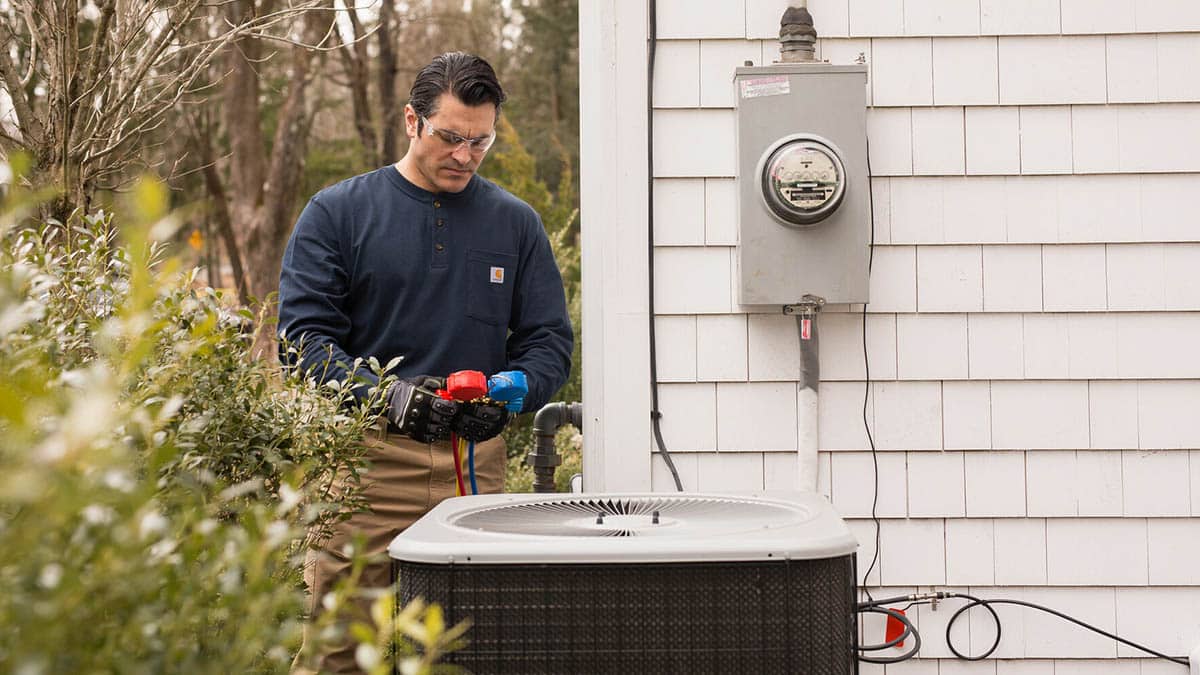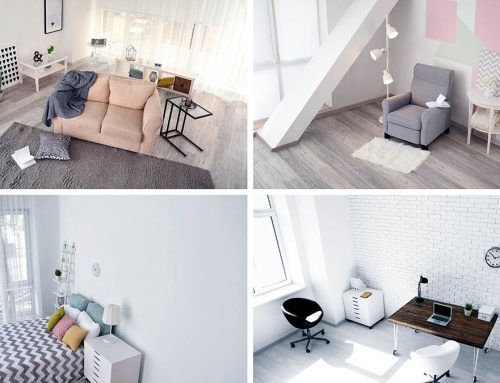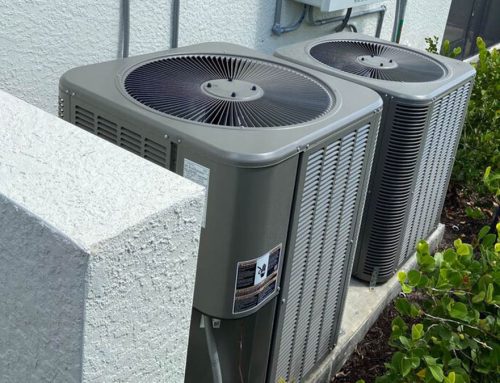How Much Does a New Central Air Conditioner Cost?

Has your central air unit (AC) been acting up? Did you tell yourself “I will get a new one next year!” all summer while suffering in the heat? Is it time to upgrade your old AC for a newer, more efficient model? Something that is likely to be the most important factor when searching for a new AC system, is price. If you are having a hard time figuring out just how much this new AC will cost you, we are here to help.
Because there are so many factors affecting the cost of an AC installation, any reputable HVAC company will require an in-home consultation before giving you an actual cost. (If they’re willing to give you a number without visiting your home, RUN! They’re either overcharging to make sure they cover any unknowns, or they simply don’t know what they’re doing.)
Our Pennsylvania customers in the Lehigh Valley and in and around Harrisburg, PA, Lancaster, PA and Reading, PA frequently ask for a ballpark figure on the cost of a central air system replacement. To help you know what to expect, we will attempt to answer the dreaded cost question here, and let you know which factors will affect your bottom line AC replacement cost.
How Do I Know When It’s Time to Replace My Central Air Conditioning System?
- Some of the common signs that it may be time to replace your central air system include:
- Your system is between 12-15 years old, or older
- You have had to make persistent repair calls
- The cost of your current repair is expensive, especially if it’s more than 25% of the cost to replace it
- Your electric bills have been sky-high due to having an old, inefficient model
- You have a noisy outdoor condensing unit
- You have had to have refrigerant added to your system.
- Your system uses R22 refrigerant, which, as of 2020, is no longer being produced
What Factors Will Affect the Cost of a New Central Air Conditioner?
There are many factors that go into the price of an AC unit. Some of the biggest factors for a Pennsylvania homeowner to consider are:
- Size of the central air unit and efficiency (SEER Rating). This is often referred to as the Tonnage of the cooling system.
- Size of the home (and area needed to cool)
- Is ductwork required or does the existing ductwork need to be modified?
- The cost of installation and labor
- Brand, features and warranty associated
While a basic, bottom-of-the-line AC system can start around $3,500-$4,000 with installation, these types of systems may not meet the needs of all homeowners, and may not even work for every home. We will discuss the factors affecting your installation costs below and give you a general idea of how each will affect your AC installation costs.
Central Air Options: Size of the Central Air Unit and Efficiency (SEER Rating)
The first thing that affects the price of your new AC unit, will be the size of the unit needed, as well as the efficiency. Generally, the larger and more efficient a central air system is, the higher in price it will be. However, when it comes to AC size, bigger is not always better. In fact an over-sized central air system can actually cause your system to run inefficiently or even break down, costing you more money and leaving your home less comfortable.
Central air units start as small as 1.5 ton (covering up to 800-1,000 square feet) and can be as big as 5 tons (covering more than 2500 square feet). These larger 5 ton units typically cost more than $5000-$6000. An HVAC professional will determine the size of the unit that will best suit your home’s needs. (If your comfort consultant doesn’t take some measurements of your home to check this, that should be a red flag – just because you have a 3 ton unit right now does not mean that that’s the ideal size for your home, especially if you’ve had issues with the comfort levels in your home or if you had made energy conservation improvements to your home.
Older central air units are often sized bigger than what is required now. New systems have much higher SEER (Seasonal Energy Efficiency Ratio) ratings, which measures that the amount of energy that is needed to provide a specific output of cooling to your home. The higher the SEER rating, the more energy-efficient the cooling system is. A higher SEER rated AC system may cost more at first, but will save you on your utility bills on the long run since it requires less energy to run.
The Minimum SEER Rating Required for New Air Conditioning = 13
You can use the chart below as an example of how SEER rating can affect your utility bills. A SEER 16 unit, for example, is twice as efficient as a SEER 8 unit, and, therefore, costs 50% less to run.
The professional doing your in-home estimate should be able to help you with a cost-savings analysis. If he or she cannot help you to understand sizing and efficiency ratings, you should probably shop elsewhere, or you may end up with an improperly-sized system – not what you want after investing thousands of dollars.
Air conditioners are available in single stage, two stage, and variable stage units. Our comfort consultant can discuss the advantages of each, and which best fits your situation.
Central Air Options: Size of the Home (and Area Needed to Cool)
A BTU (British Thermal Units) is used to determine the AC size you will need to cool your home correctly. One BTU is the amount of heat required to raise the temperature of one pound of water by one degree Fahrenheit. In air conditioning terms, this means it’s the amount of heat that an air conditioning system can eliminate from your home at 100% efficiency. The amount of BTUs needed per square foot that your home requires can vary, but can range from 15-30 BTUs. Keep in mind that ceiling height as well as the size of windows and doorways can affect this calculation. An HVAC professional can correctly determine the size of your home and the AC unit needed to cool your home.
Generally, a 2,000 square foot home will require about 36,000 BTU’s or a 3 ton AC unit.
Central Air Options: Is Ductwork Required?
Whether or not the installation of ductwork is required in your home can greatly affect the price of your central air installation project. Whether you will be using existing ductwork, need to install new ductwork, or if you opt for a ductless solution – these all factor into the cost.
Typically the most inexpensive option of the few is using existing ductwork to install your new AC. This installation includes the outdoor condenser and pad, coils, cabinet, refrigeration tubing, a new thermostat, electric wiring and an electrical connection. Because the new AC unit is being added to the existing ductwork, the extra labor costs required to install new ducts is not required.
If you do require new ductwork for your home that has existing ductwork, that extra cost is factored in. Your existing ductwork must have enough space and insulation to support the new air conditioning system. If this is not the case, an HVAC professional will have to install new ducts. Adding ductwork can significantly add to the cost of your new central air system installation – from a few hundred dollars if just a few changes are needed, to several thousand dollars for larger changes or complete new ductwork installation.
Central Air Options: Going With a Ductless Solution?
Another option is to go with a ductless air conditioning solution. Ductless mini splits are the perfect solution to homes that have no existing ductwork. And, they not only provide cooling, but heating as well. These energy-efficient mini-splits are perfect for old, historic Pennsylvania homes. They enable you to modernize this critical home operating system and eliminate hot and cold spots for good, all while preserving the historic charm and beauty of the structure, and doing your part to maintain the beauty and comfort of your special home.
Ductless mini splits also solve the problem of rooms not all cooling at the same level, or cooling four-season rooms/sunrooms. Although this type of air conditioning is not your typical central air AC unit, it still is often the best solution to certain homes. Ductless mini-splits can be designed for almost any situation – typically you will pay $3,500-$4,500 per indoor head unit. A typical installation including the outdoor compressor and 2-3 indoor head units can run about $8,000 – $12,000.
Central Air Options: The Cost of Installation and Labor
The cost of installing your AC is an important factor in the cost overall. Do not be discouraged with a contractor that offers a “higher” price range. Normally there is a fishy reason why some contractors give such inexpensive estimates. When considering your new AC installation, make sure you know who you’re dealing with. A lesser-priced company may very well indicate cheaper, inferior workmanship.
Consider how long the contractor has been around – will they be around next year to back up their work? What sort of guaranties do they offer? Are they fully bonded and insured? What is their reputation – a simple check of Google reviews will tell you what your neighbors think about the company. It is worth paying a reputable contractor to get the job done right.
The estimate that you receive from a reputable HVAC contractor will include the full costs of all parts and labor, including any necessary electrical work, asbestos removal, new ductwork, permits, etc.
Other Factors Affecting Price: Safety & Legal Requirements
Other factors that can affect your installation costs are related to safety and legal requirements. Your county (Berks, Chester, Montgomery, Lehigh, Dauphin, Cumberland, etc.) or your city or township (Bethlehem, Chester Springs, Pottstown, Harrisburg, Lancaster, etc.) can have its own specific ordinances and regulations. Additionally, many cities and municipalities require that permits be pulled for this type of home improvement project. Any reputable HVAC company will make sure that this step is complete to keep you both legal and safe.
Another concern may arise if your current system is not up to code for other reasons. Even if it was up to code when originally installed, safety and legal requirements in Pennsylvania and around the country do change over time, and what was once considered acceptable may now be considered unsafe. One example of this is “confined space” requirements, which could require accommodations be made to allow enough air flow, or could even require that your HVAC systems be moved.
Another issue could involve the presence of asbestos in your home, which would need to be safely removed by a certified asbestos professional. This requirement can add hundreds of dollars or more to your project.
Central Air Options: Brand
The last option to consider is the brand name of your new AC. A reputable HVAC contractor will specialize in just a few reputable brand names. This allows them to specialize in those brands, making sure that their employees are properly trained to install your heating system to the manufacturer’s specifications.
Just like with any product, brand names can affect pricing. If you want the “best of the best” in brand names – ones backed by a long company history, good reviews, and a rock-solid warranty – expect to pay a thousand dollars or more for the better brand. Discuss these options with your comfort consultant to see if the difference in costs is worth it for you and your family. Often times, it is. Reputable central air brands that UGI Heating, Cooling & Plumbing sells include Carrier, Goodman and Heil.
How can I pay for my new Central Air unit?
If you’ve been doing the math, you’ve seen that the cost of a new AC installation could vary greatly depending on the items that you NEED, and the options that you WANT. Your HVAC comfort consultant should provide you with a few options at different price points, and should be able to walk you through various options to pay for this home improvement project.
A reputable HVAC company will likely offer various financing options, including second-look and even no-credit check options. Your comfort consultant can walk you through these options to see what works best for your family and your budget.
Additionally, your HVAC sales person should be able to help you take advantage of any rebates that are available. Rebates may be available from specific manufactures. Additionally, many local gas and electric utilities in Pennsylvania offer rebates for converting to natural gas, or for upgrading to energy-efficient equipment. If, for example, you’re looking at a price difference of $1,000 between a unit with a 14 SEER rating and a unit with a 16 SEER rating, but there’s a $400 rebate available for the more efficient model, your actual cost difference is only $600. And the savings in your electric bill may help you to quickly make up that difference. Your comfort consultant should be able to help you evaluate all of these options.
Installing an AC with a higher SEER rating could make you eligible for tax breaks as well.
Why We Need to Visit Your Home for an Accurate Estimate
Again, any reputable HVAC contractor will require an in-home evaluation in order to give you an actual price for your new AC. Your comfort consultant should evaluate your existing system, the layout of the home and ductwork, and discuss with you any problem areas, and what you are looking for in the new central air system. He or she should discuss available financing and rebates with you and give you several options at different price points from which to choose.
If you’re ready to move forward with getting a free, customized, in-home consultation, please reach out to the experts at UGI Heating, Cooling & Plumbing – the experts in Heating for over a century. We proudly serve customers in and around the areas of Harrisburg, PA, Lancaster, PA, Reading, PA, Chester & Montgomery Counties, and the Lehigh Valley, PA.


